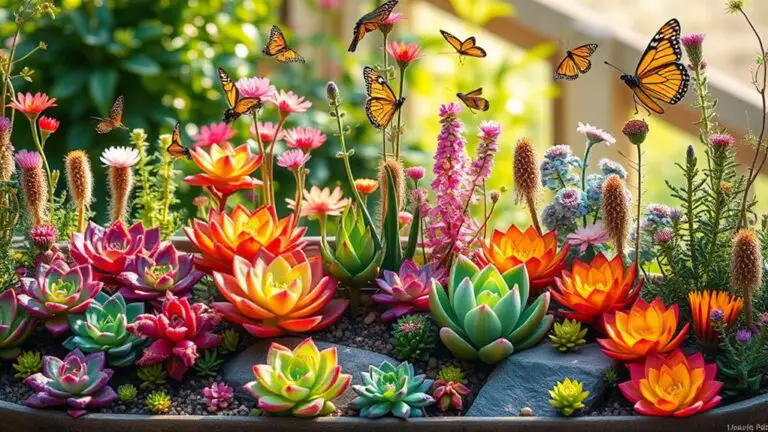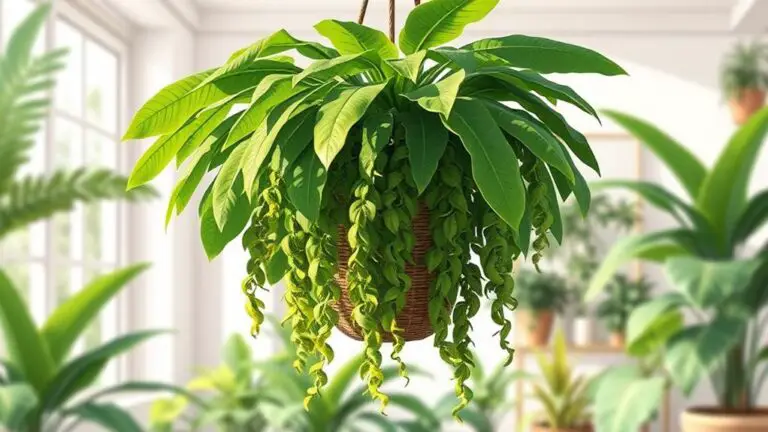7 Key Steps to Growing Cacti Outdoors Successfully
If you're looking to grow cacti outdoors successfully, it's important to follow certain steps that guarantee their health and longevity. Start by evaluating your local climate to determine which cactus species will thrive in your USDA zone. Once you've picked the right types, prepare well-draining soil by mixing horticultural sand and cactus compost. When it comes time to plant, make certain the hole allows for root expansion and water lightly afterwards. But it doesn't stop there—proper watering practices, sunlight exposure, and winter protection are also significant. Ready to discover how each step plays an essential role?
Assess Your Local Climate

Evaluating your local climate is vital to growing cacti outdoors successfully. First, determine your USDA zone. Cacti thrive best in zones 9-11, which have mild to warm climates and minimal frost. If you live in these zones, you're off to a great start.
You should also assess the temperature extremes in your area. While some cacti can handle temperatures as low as 20°F (-6°C), others need consistent warmth above 70°F (21°C).
Next, analyze the annual rainfall in your region. Most cacti prefer low humidity and dry conditions. Ideally, they thrive in areas with 8-18 inches of rain per year. Too much rain can be harmful, so it's important to know your local precipitation levels.
Sun exposure is another significant factor. Cacti need full sunlight for at least six hours a day. Make sure your garden gets enough direct sunlight, especially if you're in a location with high temperatures.
Choose Suitable Cactus Species
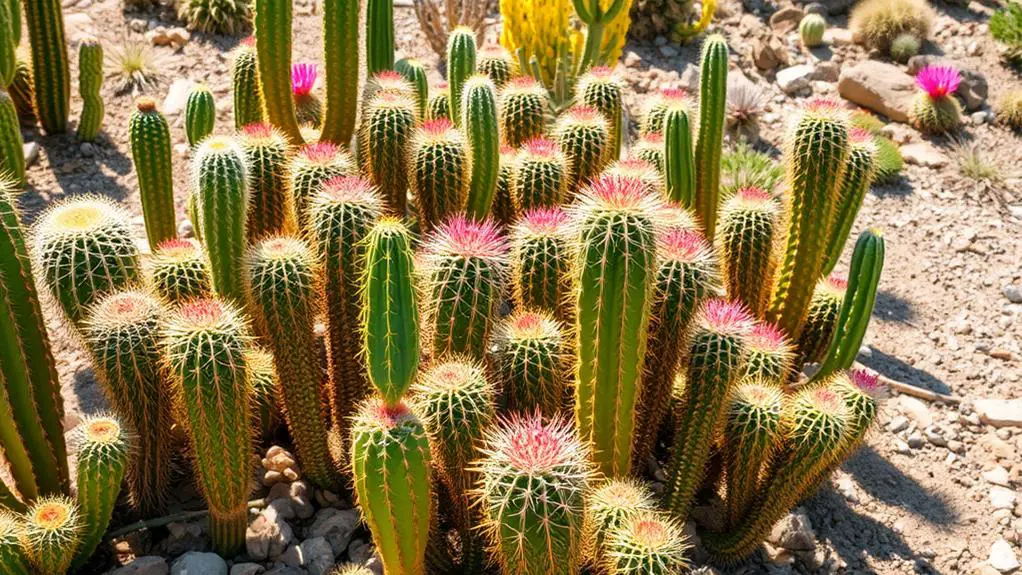
Choosing the right cactus species for your outdoor garden can make all the difference in their success. Start by selecting cold-hardy varieties like Opuntia, commonly known as Prickly Pear, and Echinocactus, known as Barrel Cactus. These types are great for regions with temperature extremes, as they can handle both heat and minimal frost.
Research your local climate conditions carefully. If you live in USDA Zones 9-11, you'll find mild to warm climates with little frost, which is perfect for many cactus species. Opt for drought-tolerant types like Ferocactus and Mammillaria. These cacti need little water once they're established, making them ideal for arid environments.
Consider the specific sunlight and drainage requirements of each cactus. Most cacti thrive in full sun, so make sure your garden has plenty of it.
Additionally, guarantee your garden has well-draining soil to prevent root rot. Evaluate their aesthetic qualities and growth habits, too. This will help you create a visually appealing arrangement that complements your outdoor space.
Prepare the Soil
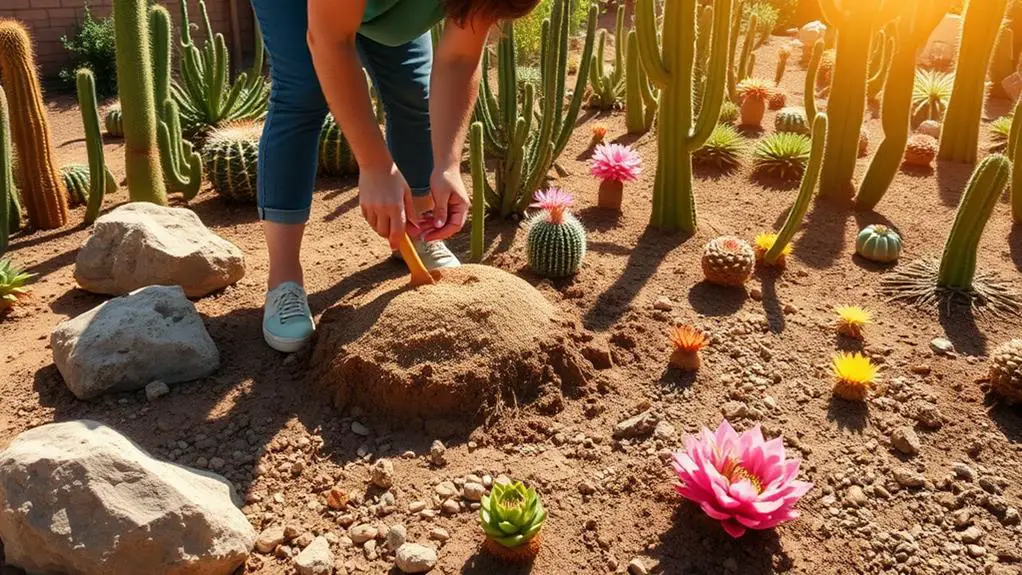
After selecting the ideal cactus species for your outdoor garden, it's time to focus on preparing the soil to guarantee healthy growth.
Cacti need well-draining soil to avoid root rot, so creating the right soil mixture is essential. Start by mixing one-third horticultural sand, cactus compost, and grit. This combination makes certain that water doesn't sit around the roots, which can be deadly for cacti.
Next, enhance the native soil by adding Miracle-Gro Garden Soil. This not only improves drainage but also provides fundamental nutrients.
Testing your soil's pH is important too; aim for a pH between 6.0 and 7.0. If the pH isn't right, you can make adjustments to create the perfect environment for your cactus.
Incorporating perlite or gravel into your soil mix further improves aeration and drainage. This is critical for your cactus's health.
When choosing a planting site, make sure it gets full sun, with at least six hours of direct sunlight each day. Proper sunlight exposure is essential for cacti to thrive.
Planting Techniques
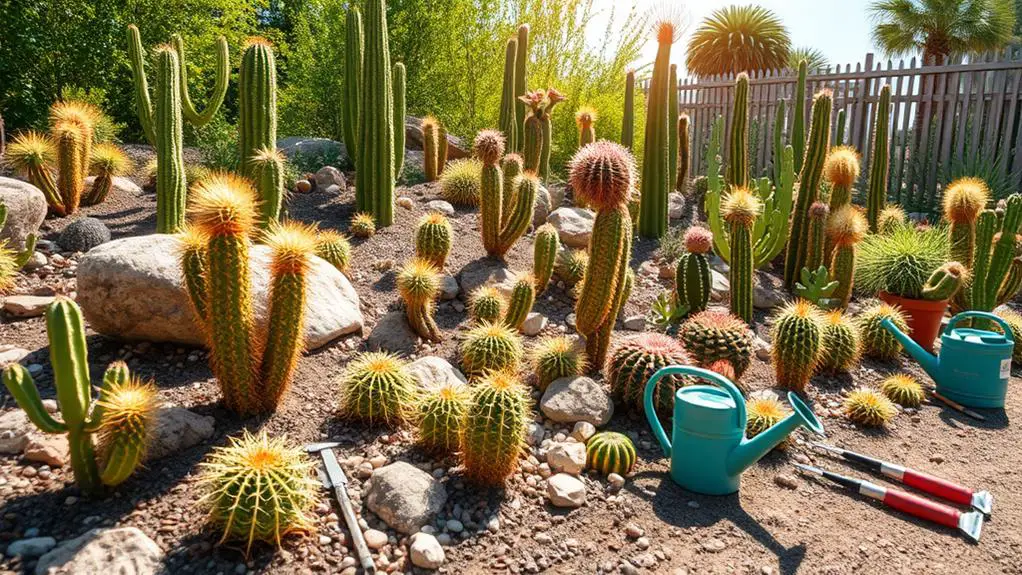
Planting outdoor cacti requires careful attention to technique to guarantee they thrive in their new environment. Start by choosing the right time; late spring through summer is ideal when the soil is warm enough for root establishment.
Prepare a planting hole that's at least 1.5 times wider than the cactus root ball. This extra space helps roots expand and settle comfortably.
Next, mix your native soil with Miracle-Gro Garden Soil. This combination provides proper drainage and essential nutrients, critical for optimal cactus growth. Proper drainage is important because cacti don't like sitting in water.
Once your soil is ready, gently place the cactus in the hole and fill it back in, ensuring the roots are covered but not too deep.
After planting, water lightly to help settle the soil around the roots. Be careful not to overwater, as too much moisture can lead to root rot. Remember, cacti are adapted to dry conditions and prefer less water.
Ensure you space your cacti adequately to allow for good air circulation and prevent overcrowding. This spacing allows each plant to get enough sunlight and air, which is necessary for their health and growth.
Watering Practices
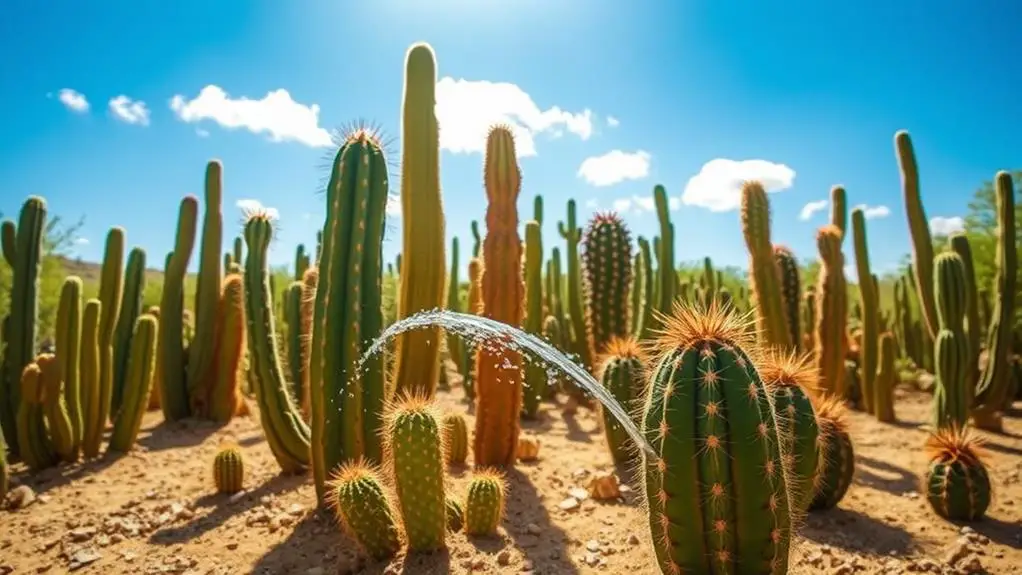
Watering your outdoor cacti correctly is essential for their health.
Use the soak-and-dry method, allowing the soil to dry out completely between watering to avoid root rot.
Adjust your watering frequency based on the season, providing more during hot months and less when it's cold.
Optimal Watering Frequency
To guarantee your outdoor cacti thrive, it's crucial to master the art of ideal watering frequency. Knowing when and how to water your cacti can make a huge difference in their health and growth.
- Water deeply but infrequently: Let the soil around the roots dry out completely between watering sessions. This might be as little as once every two to three weeks during the growing season.
- Check for signs of dehydration: In hot months, your cacti might need weekly watering. Always look for signs like shriveled stems before adding water.
- Use the soak-and-dry method: Water until it drains from the bottom, ensuring the moisture reaches the root system without waterlogging the soil. This helps prevent over-watering.
- Adjust for winter dormancy: In winter, cacti need much less water. Only water when the top few inches of soil are totally dry.
Signs of Overwatering
Recognizing the signs of overwatering is essential for maintaining healthy outdoor cacti. Overwatering is a common mistake that can lead to serious problems like root rot. One of the first signs is yellowing stems, which indicate that the roots are suffocating and unable to absorb water properly. If you notice your cactus has mushy stems, it's a clear sign that it's getting too much water.
To avoid overwatering, use the soak-and-dry method. This means you should water deeply until water drains from the bottom, then wait until the top 2-3 inches of soil is dry before watering again. In summer, this might mean watering every couple of weeks, while in winter, it could be every 4-6 weeks.
It's important to remember that a shriveled or discolored cactus can also be a sign of overwatering, not just dehydration. If your cactus appears unhealthy despite frequent watering, it might be getting too much water.
Overwatering is the leading cause of cactus death, so always check that the soil is dry before adding more water. By following these tips, you can keep your outdoor cacti thriving and avoid the pitfalls of overwatering.
Seasonal Watering Adjustments
Balancing the right amount of water throughout the year is key to keeping your outdoor cacti healthy. Adjusting your watering schedule with the changing seasons is essential for their well-being.
During the summer, your cacti will need more frequent watering since they're in their growing phase and temperatures are high. Here's a simple guide to help you:
- Summer: Water every 1-2 weeks, ensuring the top 3 inches of soil are dry before the next watering. Use the soak-and-dry method to encourage healthy roots.
- Fall: As temperatures drop and cacti enter dormancy, reduce watering to every 2-4 weeks. This helps them prepare for the colder months.
- Winter: Cacti need even less water during winter. Water only every 4-6 weeks, as cooler temperatures and lower light levels mean they require less moisture.
- Drought Conditions: Monitor your cacti for signs of dehydration, like a shriveled appearance. Adjust your watering schedule to prevent stress during prolonged droughts.
Always remember to let the soil dry completely between waterings. This practice prevents overwatering and promotes strong, healthy cacti.
Sunlight Exposure

When it comes to sunlight, cacti need at least six hours of direct exposure each day to stay healthy.
It's best to place them where they'll get full sun, especially in mild to warm climates like USDA Zones 9-11.
To avoid sunburn, gradually introduce your cacti to intense sunlight, starting with the gentle morning sun.
Optimal Sunlight Hours
To thrive, cacti need at least six hours of direct sunlight each day, making them perfect for spots with full sun exposure. Ensuring your cacti grow with plenty of sunlight is essential for their health and appearance.
Here's how you can help your cacti get the best sunlight they need:
- Full Sun Locations: Choose unshaded areas in your garden or landscape. These spots provide the direct sunlight cacti need to flourish.
- South- or West-Facing Areas: Outdoor cacti benefit greatly from these directions as they offer the longest exposure to the sun. These directions are ideal for maximizing sunlight.
- Gradual Acclimation: If moving cacti from indoors to outdoors, start with partial sun exposure. This prevents sunburn and helps the plants adjust to the stronger light. Morning sun is especially beneficial for this process.
- Avoid Excessive Shade: Placing cacti in too much shade can lead to leggy growth and fewer flowers. Cacti are adapted to bright, arid environments, so they need plenty of sunlight to stay compact and bloom well.
Sunlight Direction Importance
Understanding the importance of sunlight direction is essential for growing cacti outdoors successfully. Cacti thrive in full sun, needing at least six hours of direct sunlight each day to grow healthy and strong. This makes choosing the right location vital for your outdoor cactus gardens. South- or west-facing spots are ideal because they get the most sunlight throughout the day, providing the best growing conditions for your cacti.
Morning sun is particularly helpful when you're moving cacti from indoors to outdoors. It allows your plants to gradually adjust to direct sunlight, reducing the risk of shock. This gradual introduction can be especially important for keeping your cacti healthy and ensuring they get the light they need without overwhelming them.
Additionally, understanding sunlight direction and exposure can considerably impact your cacti's growth and flowering potential. Proper sunlight not only makes your cacti look their best but also helps them thrive and flourish.
Preventing Sunburn Damage
While sunlight is essential for cacti growth, it can also pose a risk if your plants aren't properly acclimated. It's vital to introduce them to full sun gradually to prevent sunburn damage. When cacti are suddenly exposed to intense sunlight, especially after being indoors or in shade, they can develop bleached or brown patches.
These sunburned areas aren't just unsightly; they can also lead to infections and rot.
To help your cacti thrive, follow these steps:
- Acclimate Slowly: Start by placing your cacti in a partially shaded area for a few weeks. Gradually increase their exposure to full sun to avoid stress and shock.
- Use Nurse Plants: Young or newly planted cacti benefit from nurse plants that provide shade. This protection helps them adjust until they can handle direct sunlight on their own.
- Monitor Temperature: Keep an eye on the temperature and light intensity, especially during peak sun hours. Some cacti species might need additional protection during the hottest part of the day.
- Check for Sunburn: Regularly inspect your cacti for signs of sunburn. Early detection helps you take quick action to prevent further damage.
Winter Care and Protection

When winter approaches, it's vital to protect your outdoor cacti from frost and freezing temperatures. Start your winter care by covering your cacti with breathable materials like burlap. This helps shield them from frost.
If you have potted cacti, consider moving them indoors when cold snaps are forecasted. This will keep them safe from harsh conditions.
To further protect outdoor cacti, apply a layer of mulch around their bases. Mulch provides insulation against freezing temperatures and helps reduce soil temperature fluctuations.
It's also important to focus on drainage. Make sure that water doesn't accumulate around your cacti, as excess moisture and cold can lead to root rot.
Certain cold-hardy species, such as the prickly pear, can survive in northern climates. However, you should monitor local temperature extremes and adjust care practices accordingly.
Regularly check your cacti for signs of cold stress or pests, since reduced growth during winter makes them more vulnerable.
Frequently Asked Questions
How to Grow Cactus Outdoors?
Choose cold-hardy cactus species, prepare well-draining soil, and plant in late spring. Water sparingly, ensuring full sun exposure. Gradually introduce young cacti to sunlight. Use pots 1.5 times wider than the root ball for best results.
How Do You Grow Cactus Step by Step?
Start by choosing a sunny spot. Mix well-draining soil with sand and grit, then plant in late spring. Water lightly after planting and let the soil dry out completely between waterings. Monitor for pests regularly.
How to Encourage Cactus Growth?
To encourage cactus growth, make certain they get at least six hours of direct sunlight daily. Water sparingly when the top 3 inches are dry, use well-draining soil, feed them monthly during growing season, and protect from extreme cold.
How Do You Prepare Soil for a Cactus Garden?
To prepare soil for a cactus garden, mix one-third horticultural sand, cactus compost, and grit. Incorporate native soil with perlite or gravel, guarantee good drainage with raised beds, and test pH for slightly acidic to neutral levels.
Conclusion
You've got this! By following these seven key steps, you'll set your cacti up for success. Remember to assess your climate, choose the right species, and prepare well-draining soil. Plant carefully, water with the soak-and-dry method, and guarantee they get plenty of sunlight. Don't forget to protect them from frost in winter. With these tips, you'll soon have a thriving cactus garden that you can be proud of. Happy gardening!





